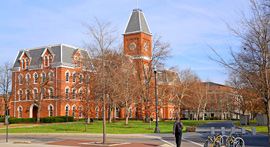Academics
With more than 150 years of traditions and achievements on the record, Kansas State University is the nation’s first operational land-grant university, offering more than 250 undergraduate majors and programs across three campuses, as well as various global online courses. The university’s sprawling 2,300-acre main campus in Manhattan, Kansas (nicknamed “The Little Apple”) includes comprehensive agricultural and research facilities, while the newest campus, Olathe, is located in the Kansas Biosciences Park and works to expand partnerships between students, researchers, and companies. “Leadership opportunities are always within an arm’s length,” says a student. On the administration’s part, there is excellent “communication of resources available to students,” and the school is “very conscious of showing students what they are paying for and listening to student feedback in what prices should be for fees/services.” In demonstrating further commitment to quality, “professor performance grades are sent out to students at the end of every semester.”
At this research powerhouse, faculty members not only conduct “amazing research that is being nationally recognized” but also strive to do in a way that lets them “pass on their knowledge to the students.” Such efforts are also recognized in and out of the classroom, whether that’s in the way teachers “are skilled at making classes interesting” or how they lead review sessions “to better help students focus on harder topics.” (Students also mention how discussion boards are “largely utilized for engagement.) In general, professors are praised for responding “quickly and well to emails” and overall come across as “approachable and really want to see their students learn and succeed.”
Student Body
K-State is composed of “many international students, first generation students, and students from virtually all race, religion, and age,” as well as “many students who grew up on a farm or other rural areas,” all of whom contribute to a “wonderful community mindset.” Traditions abound here, and “the university instills this very real feeling of belonging and family” known as the Wildcat Way. “Purple pride is taken very seriously” here, so much so that one student notes how “We see that Wildcat, and know we’re part of the same family.” This is “a big school with a small-town feel,” and everyone is “exceedingly friendly and proud of the university.” The school itself provides plenty of ways for students to be involved, and there are “a multitude of opportunities for students to find their own space to grow and succeed in.”
Campus Life
The college town of Manhattan “provides those from bigger cities with the pros of a smalltown feel (community, laid-back style) while also giving students from rural areas a more city-like lifestyle.” As one student puts it: “It is super easy to balance school and a social life here since the majority of the people who live here are students.” The bars, restaurants, and shopping in the neighborhood of Aggieville make it “a vibrant hotspot for activity every weekend and even on weekdays.” The “gym facilities and hiking trails nearby are beautiful and a great way to get moving,” and “the city and university maintain public sidewalks and trails for those wishing to bike/run.” All student amenities “are within walking distance,” and for fun, “many people attend parties, hang out with friends, and attend events hosted in the student union.” Intramurals are wildly popular, and Greek life “is fun but not too overpowering,” ensuring that the overall vibe allows students to “focus on their studies and dedicate their daytime hours to ensuring they complete their coursework.”





